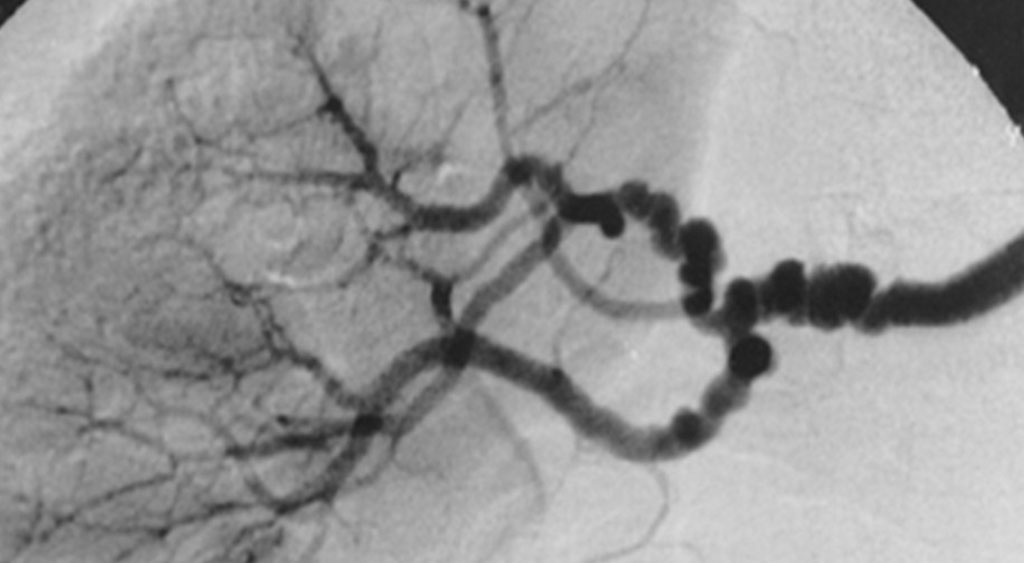Mutations in Gene Show Predisposition to Artery-Damaging Disease
By LabMedica International staff writers
Posted on 20 Dec 2016
Scientists have discovered that loss-of-function alterations in the YY1AP1 gene can lead to fibromuscular dysplasia (FMD) or similar arterial diseases, including Grange syndrome. The link helps explain what causes this class of arterial disease, which often strikes without warning, as there is currently no test to assess risk of developing FMD.Posted on 20 Dec 2016
“This is an important step in understanding the underlying molecular mechanisms of this unexplained and puzzling condition that often affects women,” said Dianna Milewicz, MD, PhD, University of Texas Health Science Center at Houston (Houston, TX, USA), who led the team that made the discovery, “The finding is a critical step in developing treatments.”

Image: Fibromuscular dysplasia (FMD) of renal arteries. Image shows \"string-of-beads\" arterial lesions, a feature of multi-focal FMD caused by areas of relative stenoses alternating with small aneurysms. The diameters of the aneurysms exceed the normal diameter of the artery, a sign characteristic of medial FMD. A similar bead appearance may be seen in perimedial FMD, but the diameters of the beads do not exceed the normal diameter of the artery. Note the involvement of branch renal arteries (Photo courtesy of the Journal of Rare Diseases).
The study involved a family with a rare genetic disorder, Grange syndrome, which is also characterized by abnormal cell development on arterial walls. Grange syndrome is characterized by severe and early onset FMD-like arterial disease. “When we compared the chromosome sequence of family members with and without Grange syndrome, we identified mutations in a gene, called YY1AP1, in affected individuals,” said Dongchuan Guo, PhD, the study’s lead author and an associate professor at McGovern Medical School.
Mutations in YY1AP1 causing Grange syndrome were confirmed in additional unrelated families. The team also confirmed their findings through cell biology studies and performed genetic testing involving 282 people with FMD and a control cohort. “This is a good example of how the investigation of a very rare genetic condition that has been identified in only a few individuals can lead to a better understanding of a more common medical problem such as FMD, which may benefit a broader population,” said Dorothy K. Grange, MD, study co-author and a professor at Washington University School of Medicine.
FMD can involve the arteries going to and within the brain, leading to strokes and transient ischemic attacks; it can affect the arteries going to the kidneys, leading to high blood pressure. When doctors suspect a person has FMD, they typically order imaging to see if they can locate the narrowed artery or arteries. While there is no cure, in severe cases, doctors insert tiny wires or catheters into the blood vessels to widen them.
“Diagnosis and treatment of patients with FMD remains a clinical challenge. The recent discovery of Dr. Milewicz and her team is a significant leap toward better understanding of the causative factors in this mysterious disease,” said Ali Azizzadeh, MD, chief of vascular and endovascular surgery at McGovern Medical School.
“YY1AP1 mutations predispose to vascular lesions characteristic of FMD, thus indicating that FMD can result from mutations in a single gene,” the authors wrote, “Thus, these data provide insight into the pathogenesis of FMD, an unusual and poorly understood vascular disease.”
The study, by Guo DC et al, was published December 8, 2016, in the journal The American Journal of Human Genetics.
Related Links:
University of Texas Health Science Center at Houston













